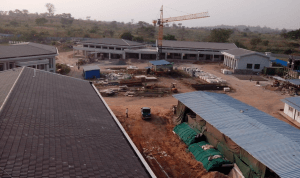University of Health and Allied Sciences in retrospect: Three years of strides in academic expedition
 The University of Health and Allied Sciences (UHAS), is one of the twin newest public universities established by the late President John Evans Atta Mills in 2012.
The University of Health and Allied Sciences (UHAS), is one of the twin newest public universities established by the late President John Evans Atta Mills in 2012.
The other one is the University of Energy and Natural Resources, situated in the Brong-Ahafo Region.
Its permanent campus, including the central administration, is situated in Ho. The second campus is located in Hohoe.
Indeed, it is the first publicly-funded and state university dedicated only to medical training in the country and situated in the Volta Region.
ACADEMIC PROGRAMMING
UHAS has commenced a Medical Degree programme; this is taking place a year ahead of schedule; enrolling 43 pioneering students for the 2014/2015 academic year.
The University currently operates five schools namely, School of Basic and Biomedical Sciences, School of Nursing and Midwifery, School of Medicine, School of Public Health and School of Allied Health Sciences.
Others yet to be established are; School of Pharmacy, School of Sports and Exercise Medicine, School of Dentistry, Institute of Medical Education and Institute of Traditional and Alternate Medicine .
POPULATION/PHYSICAL STRUCTURES
Apparently, stakeholders are getting excited about increasing student numbers, and the prospects in UHAS. A total of 539 students were admitted out of the 2,500 applications received for the 2014/2015 academic year.
The total student population now stands at 1,009 including admissions for the 2013/2014 and inception 2012/2013 academic years.
Current limited facilities could only permit the admission of just a fraction of applicants, but the rate of infrastructural development in UHAS has rekindled the dreams of many parents, guardians and prospective students.
Facilities for the School of Basic and Biomedical Sciences are under construction by the China Yanjian Group Company, with work about 75 per cent complete. Other projects include library and laboratory complexes, and the construction of a 1,200-seater capacity auditorium complex in Ho.
Additionally, a 10-unit lecture theatre complex for the School of Public Health, has been completed at the Hohoe Campus; with other permanent facilities for that campus progressing steadily.
UHAS HOME GROWN INNOVATIONS
In order to remain relevant, UHAS is implementing well thought-through innovations to leverage teaching and learning. These include; Compulsory Vocational Training/Internship, where students spend eight weeks of the long vacation for internship in health facilities to subject theoretical lessons to practical realities.
Another is the strengthened foundation in Mathematics and Science, which is a scheme that allows level 100 students to spend three semesters in the School of Basic and Biomedical Sciences, with well-grounded lessons in Mathematics and the Sciences, fine-tuning students for the herculean task ahead.
Again, UHAS lunch for Level 100 Students and accommodation schemes are obligatory, serving a hot meal a day, in order that students can concentrate during lectures, as well as room space for occupation.
Tailor-made access and top-up professional courses intended to upgrade competences of active health workers, are available in nursing, midwifery and public health, with others being designed for public consumption.
Indeed, tutor strength is being bolstered by sponsorship packages for members and prospective members of staff willing to attain higher qualifications, which over 15 doctors and other health professionals are upgrading themselves and are expected to impart skills on return.
SCHOOL FEES
The opportunities offered by the University come with costs that are intrinsic of overall fees for the academic year, shoring-up fees but when critically analyzed per the various components, it is believed that cost integrated is justifiable, hence falling in line with fees of other State Universities.
Despite that, there are avenues for staggering payment.
A comparison of level 100 students across State Universities for the 2014 / 2015 academic year, shows the following thresholds: UHAS -GH₵1,440.00, UG School of Allied Health – GH₵1,515.00, UCC Nursing students – GH₵1,566.00, KNUST School of Medical Sciences – GH₵1,015.73.
Contextually, the cost of UHAS home-grown innovations, that is an addendum to its fees are: vocational training – GH₵300, lunch – GH₵504 (i.e. GH₵4.00 x 7 days x 18 weeks) and accommodation – GH₵900.00.
HUMBLE ACHIEVEMENTS
Although UHAS is only three years old, a number of achievements have already been recorded. Students of the University emerged winners in a just-ended quiz competition involving five other older tertiary institutions, namely, the University of Ghana, Kwame Nkrumah University of Science and Technology, University of Cape Coast, College of Health, Kintampo and the Premier School of Medical Laboratory Technology, which was organised by the Federation of Ghana Medical Laboratory Science Students’ Associations.
Again, UHAS placed second out of 32 institutions that took part in the fourth edition of the TV Africa’s ‘Knowing Africa’ competition in 2013.
CONCLUSION
UHAS which is branded on “Health for Development” envisages to become a national and global brand responsible for grassroots community healthcare delivery within the next 5-10 years.
by Maxwell Awumah
Source: GNA
